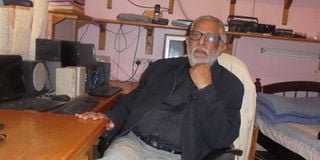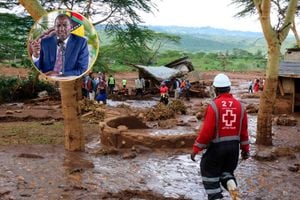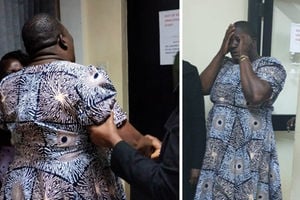Blind priest with a vision

Father Luiz Saldanha , a blind priest who conducts mass excellently. PHOTO| COURTESY
What you need to know:
Father Saldanha’s grandfather came to Kenya at the beginning of the 20th century. He too had been born in Kenya, but he grew up and spent most of his childhood in the Indian state of Goa, in the village of Saligao.
He married in Goa and then came to Kenya with his bride in 1940 to settle and start a family.
The priest is the youngest of three siblings: the eldest, Leandro Jose, was a pilot with Kenya Airways and is now retired with his family in Toronto, Canada; the second born, Lucinda, is now a retired teacher living with her family in Sydney, Australia.
Father Luis Saldanha was not born blind. Neither was he blind in his childhood.
In fact, he could see quite well by the time he says he heard his calling to be a Catholic priest at the age of 12 to “proclaim good news to the poor”.
However, a degenerative disease robbed him of his sight — but it never diminished his passion. Instead, Father Saldanha, 68, has become something of a miracle, especially as he carries out his religious duties. He strides about with great confidence at the altar and, when he speaks, there is not a tinge of self-doubt. It is as though he can see everyone in the church. It would take a lot of convincing for a newcomer to agree the Father is completely blind.
“I have a hereditary eye condition called retinitis pigmentosa, where cells in the retina gradually die for lack of a protein. Though for long I knew of my condition, it only gradually affected my ability to see — I was still driving in 1989,” he says, adding that his condition became worse.
This has been the story of Father Saldanha’s life as a priest for the past 42 years. In November 2013, he received many congratulatory messages as he celebrated the landmark 40 years in priesthood.
“Ever since I was 12, I knew priesthood was my calling. I even wrote a story about my desire to become a priest when I was just 12!” he told Lifestyle.
“Basically, looking back, I feel that as a priest I answer a call from Jesus to be Him in this world and to lead His precious people to the gates of Heaven, providing help through sacraments.”
Father Saldanha was born Jose Luis Saldanha on February 1, 1947, on the outskirts of Nairobi. At the time, Goans were treated by British colonialists as second-class citizens.
It was at the height of racial discrimination. Whites and Goans were not allowed to mix. Many Goans were in administrative jobs, mostly clerks. Some of them, most notably Pio Gama Pinto — who was later assassinated in 1965 — were involved in the struggle for Kenya’s independence.
Father Saldanha’s grandfather came to Kenya at the beginning of the 20th century. He too had been born in Kenya, but he grew up and spent most of his childhood in the Indian state of Goa, in the village of Saligao. He married in Goa and then came to Kenya with his bride in 1940 to settle and start a family.
The priest is the youngest of three siblings: the eldest, Leandro Jose, was a pilot with Kenya Airways and is now retired with his family in Toronto, Canada; the second born, Lucinda, is now a retired teacher living with her family in Sydney, Australia.
Father Saldanha studied at Dr Ribeiro Goan School (now Parklands School) and completed his Form IV in 1963.
Before he joined the seminary in Rome, Italy, he worked as an accountant at two companies in Nairobi, first a coffee and tea exporting business, and then an insurance company.
When he returned from Rome, having done well in his studies, he was ordained on November 17, 1973 by Maurice Michael Cardinal Otunga.
Father Saldanha was the first Kenyan Catholic priest to acquire a degree in Scriptures from the Biblical Institute in Rome and the Hebrew University in Jerusalem.
After graduation, he taught scripture at St Thomas Aquinas Seminary in Nairobi’s Lang’ata and, for many years, he was a chaplain at Kenyatta University. He was later appointed secretary and procurator of the Archdiocese of Nairobi.
Father Saldanha says his motivation has always been to help the less fortunate. For example, in 1984 when famine struck Rwanda, South Sudan, Uganda and Ethiopian, Father Saldanha, then a diocesan priest, spent most of his time managing a refugee programme after which he served in various parish appointments at churches in Nairobi.
How has he accomplished all this with failing eyesight? “Technology” is the one word he fuses with “faith” and “determination” to explain his amazing success. Though he needs an assistant and a driver to find his way around town, he is stubbornly independent.
THIS IS HOW IT WORKS
Father Saldanha can type on a keyboard to communicate through e-mail and prepare lesson notes and sermons on a computer with the aid of a screen reader (software that allows blind or visually impaired users to read text displayed on a computer screen, aided by a speech synthesiser or braille display).
“A digital recorder helps me to celebrate Mass and read the Gospel,” he says.
To show how it works, he removes a small metal object from a pocket inside his crisp black blazer. Then he untangles the headphones and presses the play button effortlessly.
His distinctive voice is heard in the recording as he recites the gospel and the prayers.
“I record this the day before I celebrate Mass,” he says. “I record it in parts so that I can press fast forward and pause because, as you know, the mass follows an order.”
The trick is to repeat what is said in the recording as it plays, which is no mean task.
“Though I am blind, this has never stopped me from my vocation and I am truly lucky to have access to such technology — screen readers, touch screen mobile phones with voice recognition, and so on,” he says.
Yes! Father Saldanha uses a mobile phone. Again, he reaches into his blazer pocket and retrieves two smartphones.
“This is how I communicate — try calling me and see what happens,” he tells this writer.
Moments later, as the call connects, a robotic voice recites: “Daniela Oliveira calling, voice call.”
And that is not all! Father Saldanha says he tries his best to use as many applications on the phone as he can.
“I use Viber and WhatsApp, although I am still getting used to this new gadget,” he says, singling out the popular messaging applications.
As he slides his fingers across the touch screen of one of the phones, another robotic voice helps him navigate between the pages and the applications he touches. This, he says, is “how I text you or call you”. To write a message, he dictates words to his phone, which converts them into text.
Father Saldanha is efficient with technology and he looks to the day when he will be able to use GPS (Global Positioning System) “to help me walk around without any help”.
Does he use braille? “Yes! I do, but I am still a bit slow at it to derive the same joy as I do using other means of communication,” he says.
For a while in the 1980s, he served as Cardinal Otunga’s secretary and has fond memories of the great man who is on the road to sainthood, saying the cleric not only cared for the flock but also for his priests. The cardinal died in 2003.
“One thing most people know him for is kindness. He was so kind and caring to all he met. Every time people would kiss his hand after shaking it as a sign of respect he would say, ‘why are you kissing my hand, for I am just a common man like you, not a saint!’” Father Saldanha recalls.
He explains that the cardinal would go out of his way to visit people of other denominations and religions, like Hindus and Muslims.
He says: “If only he knew that he was going to become a modern-day saint in the 20th century!”
Father Saldanha also says he met Pope John Paul II on his second visit to Kenya in 1985, and Mother Teresa, who famously devoted her life to the destitute.
“They were kind-hearted. Meeting them was truly one of the great gifts I have received working as a priest,” he says.
Father Saldanha lives in Ruaraka and is often called to celebrate mass at various churches in Nairobi Archdiocese.
He has seen many changes unfold in the country over the years. And though he remembers with immense sadness the deadly violence of the 2007 elections, he is happy about the changes he hears about now.
“Kenya has come a long way. People used to be poor and the middle class was very small. Now the middle class has grown and a lot of the population identifies with this group. In the past, things were different; people were able to live comfortably with a few thousand shillings, but now the cost of living has certainly gone up,” he says.
He also marvels at how technology has evolved over the years. “In the past, there were only a few TV and radio stations. But now I switch on the radio and I can listen to all sorts of stations,” he says with excitement, adding that there is a lot more freedom of speech, and people are able to voice their opinion on various matters without fear.
He says he has never doubted his calling to be a priest, because his blindness gives him a chance to identify with the weak and the suffering.
He also says his impaired eyesight has given him an opportunity to put into action what is preached in the Bible and to imitate the Master by reaching out to those in need. Loss of sight, he says, never robbed him of his vision to serve.
Special correspondent Daniela Oliveira, a student at USIU-Africa majoring in International Relations and Finance, is a correspondent for the ‘Contact Chaplaincy’ in the UK




